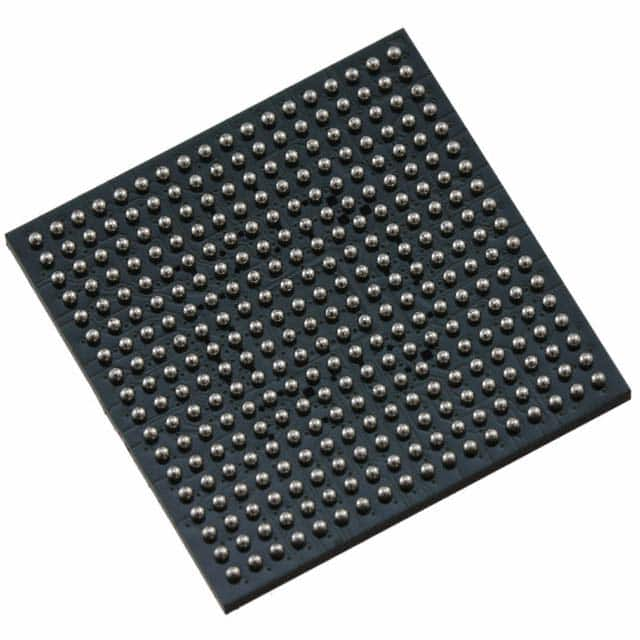LCMXO2280E-4FTN324I
Product Overview
Category
The LCMXO2280E-4FTN324I belongs to the category of Field-Programmable Gate Arrays (FPGAs).
Use
This FPGA is commonly used in various electronic applications that require programmable logic devices. It provides designers with flexibility and versatility in implementing digital circuits.
Characteristics
- High-performance FPGA with advanced features
- Low power consumption
- Compact size
- Easy to program and reconfigure
- Wide range of I/O options
- Robust and reliable design
Package
The LCMXO2280E-4FTN324I comes in a compact package, suitable for surface mount technology (SMT) assembly. The package type is FTN324, which refers to a fine-pitch, thin quad flat no-leads package.
Essence
The essence of the LCMXO2280E-4FTN324I lies in its ability to provide a customizable digital logic solution for various applications. It allows users to implement complex digital circuits without the need for custom-designed integrated circuits.
Packaging/Quantity
The LCMXO2280E-4FTN324I is typically packaged in reels or trays, depending on the manufacturer's specifications. The quantity per reel or tray may vary, but it is usually in the range of several hundred to a few thousand units.
Specifications
- Logic Elements: 2280
- Flip-Flops: 4560
- Block RAM: 360 Kbits
- Maximum Frequency: 300 MHz
- I/O Pins: 324
- Voltage Range: 1.2V - 3.3V
- Operating Temperature: -40°C to 85°C
Detailed Pin Configuration
The LCMXO2280E-4FTN324I has a total of 324 I/O pins, which are configurable for various purposes. The pin configuration is as follows:
- Pin 1: VCCIO
- Pin 2: GND
- Pin 3: IO0
- Pin 4: IO1
- ...
- Pin 323: IO322
- Pin 324: IO323
Functional Features
- High-speed performance
- Flexible and reconfigurable architecture
- Support for various communication protocols
- On-chip memory resources
- Built-in security features
- Low power consumption
- Easy integration with other components
Advantages and Disadvantages
Advantages
- Versatile and customizable digital logic solution
- Faster time-to-market compared to custom-designed integrated circuits
- Lower development costs
- Easy prototyping and testing
- Ability to reconfigure the FPGA for different applications
Disadvantages
- Limited resources compared to application-specific integrated circuits (ASICs)
- Higher power consumption compared to dedicated hardware solutions
- Steeper learning curve for programming and configuring FPGAs
Working Principles
The LCMXO2280E-4FTN324I operates based on the principles of field-programmable gate arrays. It consists of an array of programmable logic elements interconnected through configurable routing resources. These logic elements can be programmed to implement various digital functions, such as logic gates, arithmetic units, and memory elements. The configuration of the FPGA is stored in non-volatile memory and can be modified by the user.
Detailed Application Field Plans
The LCMXO2280E-4FTN324I finds applications in a wide range of fields, including:
- Telecommunications: Used in network routers, switches, and base stations for high-speed data processing.
- Industrial Automation: Employed in control systems, motor drives, and robotics for real-time control and monitoring.
- Automotive: Integrated into automotive electronics for functions like engine management, driver assistance systems, and infotainment.
- Aerospace and Defense: Utilized in avionics, radar systems, and communication equipment for reliable and high-performance digital processing.
- Consumer Electronics: Found in smart TVs, gaming consoles, and wearable devices for multimedia processing and connectivity.
Detailed and Complete Alternative Models
- LCMXO2560E-4FTN324I
- LCMXO640E-4FTN324I
- LCMXO1200E-4FTN324I
- LCMXO2280C-4FTN324I
- LCMXO2-7000HE-4FTN324I
These alternative models offer similar functionality and characteristics to the LCMXO2280E-4FTN324I, but with varying capacities and specifications.
In conclusion, the LCMXO2280E-4FTN324I is a high-performance FPGA that provides designers with flexibility and versatility in implementing digital circuits.
Senaraikan 10 soalan dan jawapan biasa yang berkaitan dengan aplikasi LCMXO2280E-4FTN324I dalam penyelesaian teknikal
Sure! Here are 10 common questions and answers related to the application of LCMXO2280E-4FTN324I in technical solutions:
Q: What is the LCMXO2280E-4FTN324I? A: The LCMXO2280E-4FTN324I is a low-cost, low-power FPGA (Field-Programmable Gate Array) device manufactured by Lattice Semiconductor.
Q: What are the key features of the LCMXO2280E-4FTN324I? A: Some key features include 2280 LUTs (Look-Up Tables), 80 I/O pins, 4-input look-up tables, embedded block RAM, and low power consumption.
Q: What are some typical applications of the LCMXO2280E-4FTN324I? A: The LCMXO2280E-4FTN324I is commonly used in applications such as industrial automation, consumer electronics, communication systems, and IoT devices.
Q: How can I program the LCMXO2280E-4FTN324I? A: The LCMXO2280E-4FTN324I can be programmed using Lattice Diamond or Lattice Radiant software tools, which support various programming languages like VHDL and Verilog.
Q: What is the maximum operating frequency of the LCMXO2280E-4FTN324I? A: The maximum operating frequency of the LCMXO2280E-4FTN324I depends on the specific design and implementation, but it can typically reach frequencies up to several hundred megahertz.
Q: Can I use the LCMXO2280E-4FTN324I for real-time signal processing? A: Yes, the LCMXO2280E-4FTN324I can be used for real-time signal processing applications due to its high-speed capabilities and programmable nature.
Q: Does the LCMXO2280E-4FTN324I support external memory interfaces? A: Yes, the LCMXO2280E-4FTN324I supports various external memory interfaces such as DDR3, DDR2, and SPI flash memory.
Q: Can I use the LCMXO2280E-4FTN324I in battery-powered devices? A: Yes, the LCMXO2280E-4FTN324I is designed to be power-efficient, making it suitable for battery-powered devices where low power consumption is crucial.
Q: Are there any development boards available for the LCMXO2280E-4FTN324I? A: Yes, Lattice Semiconductor provides development boards like the LCMXO2280E-B-EVN, which allow users to prototype and test their designs using the LCMXO2280E-4FTN324I.
Q: Where can I find more technical documentation and resources for the LCMXO2280E-4FTN324I? A: You can find more technical documentation, datasheets, application notes, and other resources on the official Lattice Semiconductor website or by contacting their customer support.


